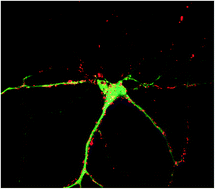Cytotoxic effects of upconversion nanoparticles in primary hippocampal cultures†
Abstract
The widespread use of nanomaterials causes public concerns associated with their potential toxicological hazards. New-generation nanomaterials – upconversion nanoparticles (UCNPs) – hold promise for theranostics applications due to their unique optical properties, enabling imaging at the sub-centimetre depth in live biological tissue. In brain tissue, nanoparticle-aided optical imaging and treatment are deemed desirable. To this aim, we carried out cytotoxicity studies of UCNPs in primary hippocampal cultures. The most common core/shell UCNPs (NaYF4:Yb3+:Tm3+/NaYF4) were synthesized using a solvothermal method and hydrophilized with amphiphilic polymaleic anhydride octadecene (PMAO); polyethyleneimine (PEI). Bare UCNPs were produced by using tetramethyl ammonium hydroxide (TMAH). PMAO-, PEI- and TMAH-UCNPs (0.8 mg mL−1) were incubated for 72 hours with primary hippocampal culture and exhibited noticeable cytotoxicity. Our studies showed profound morphological modification of all treated cells with the maximum and minimum uptake observed in PMAO- and TMAH-UCNP-treated cells, respectively. The spontaneous calcium activity in cells treated with TMAH-UCNP, PMAO-UCNP dropped to (17 ± 3)%, (6 ± 3)% of its original level and was completely inhibited in the PEI-UCNP-treated cultures. This study demonstrated that bare and polymer surface-coated upconversion nanoparticles are toxic to dissociated hippocampal cells, evident through aberrant morphological changes, deviant variations of Ca2+ activity, and cell death.



 Please wait while we load your content...
Please wait while we load your content...